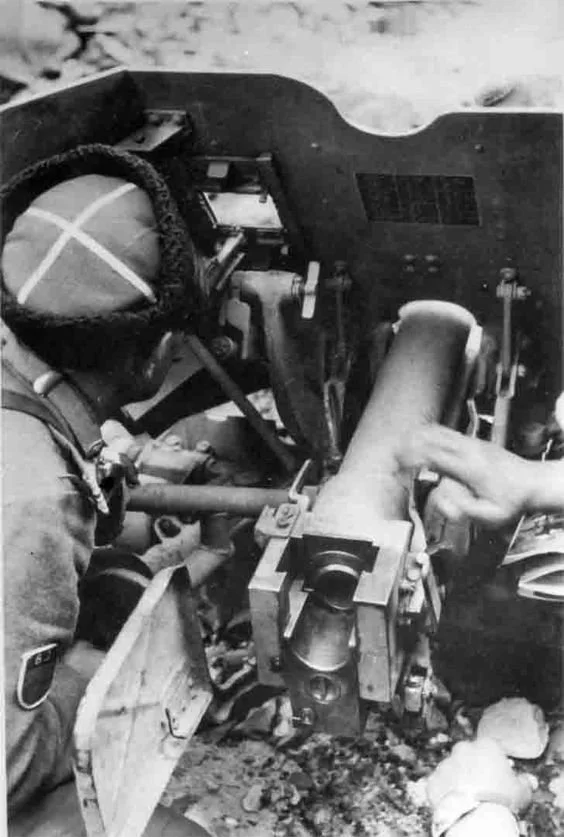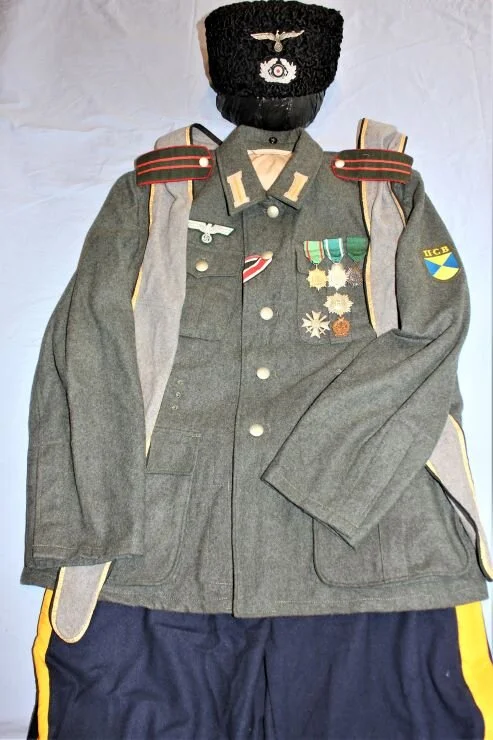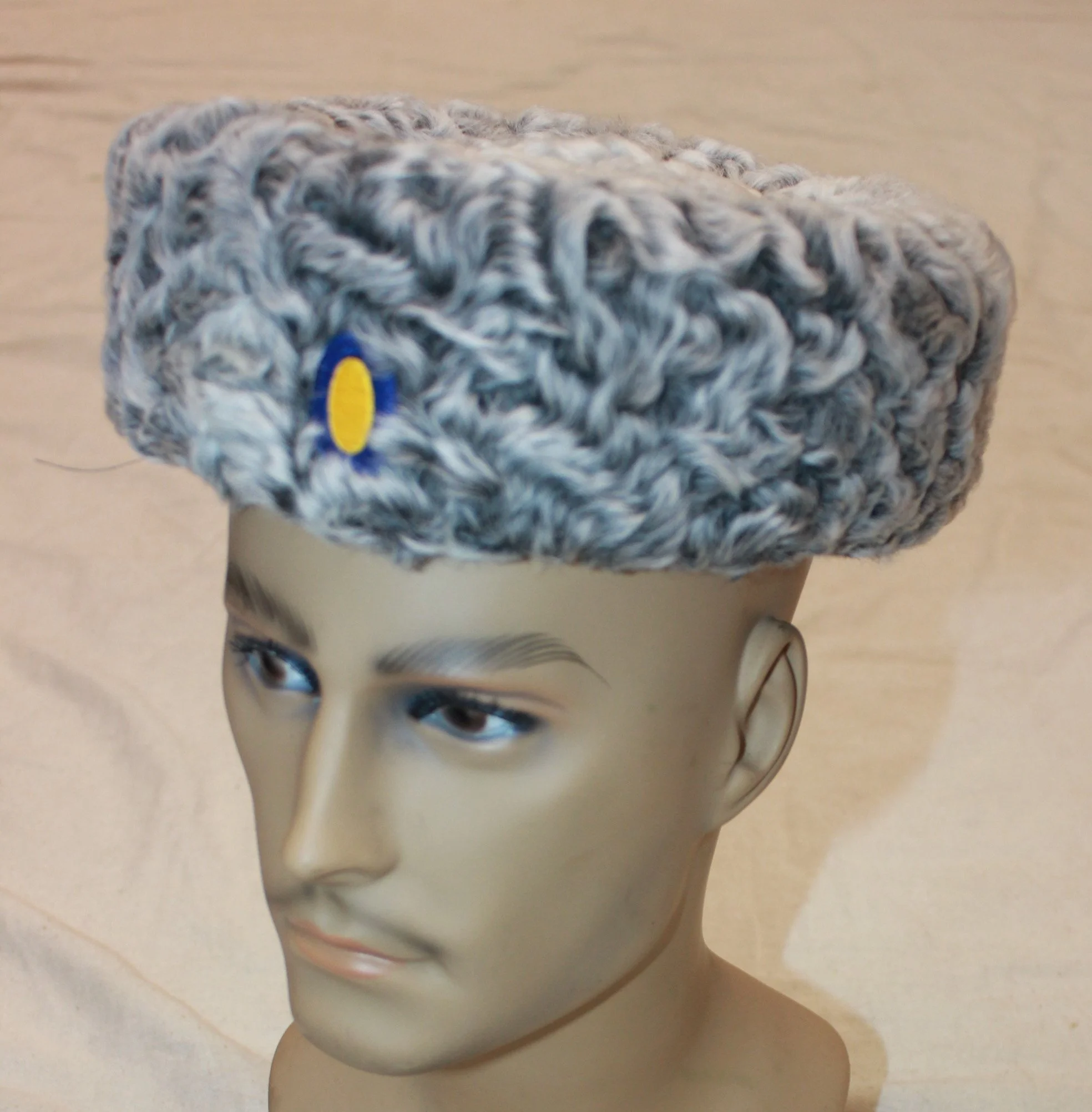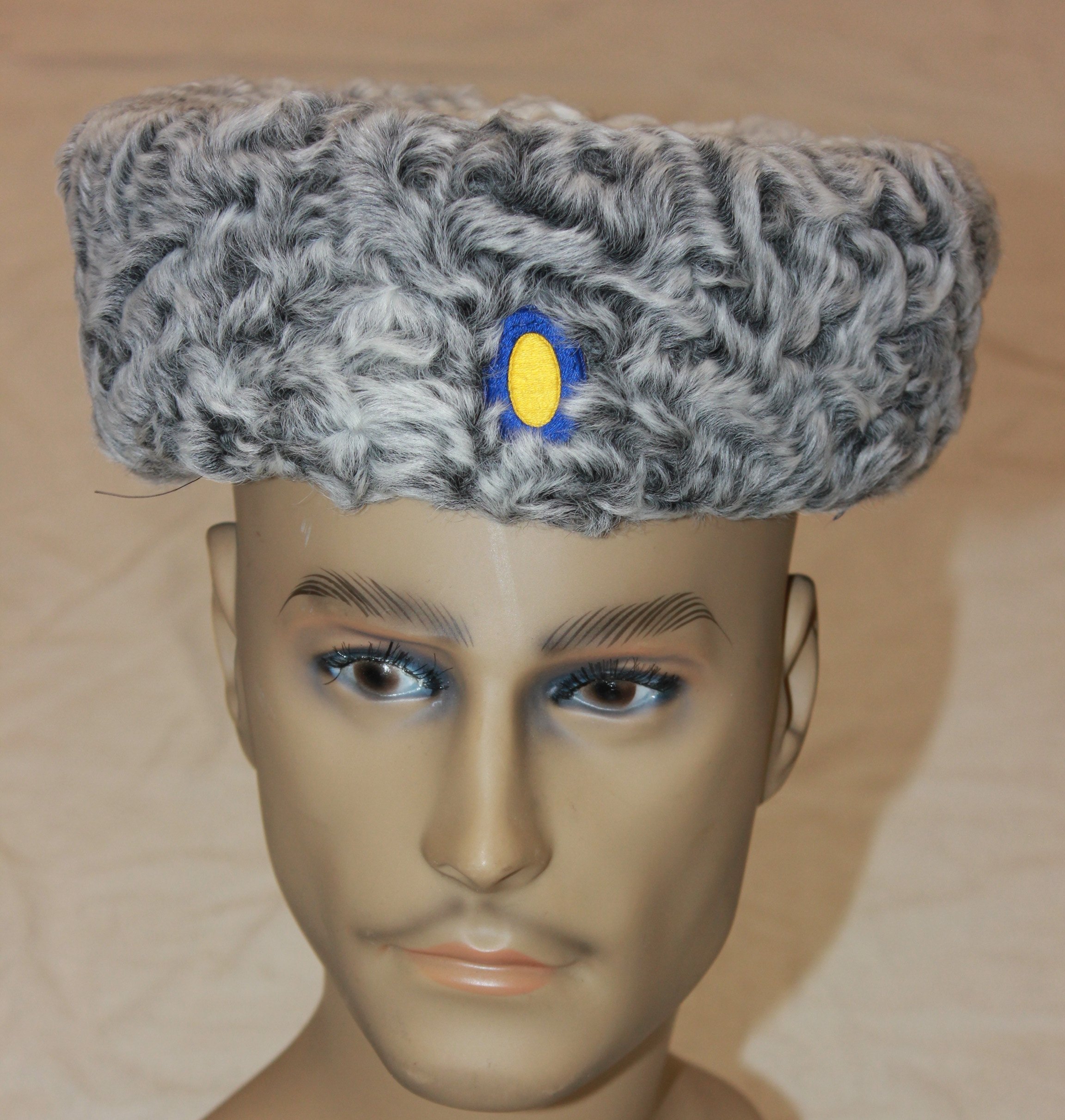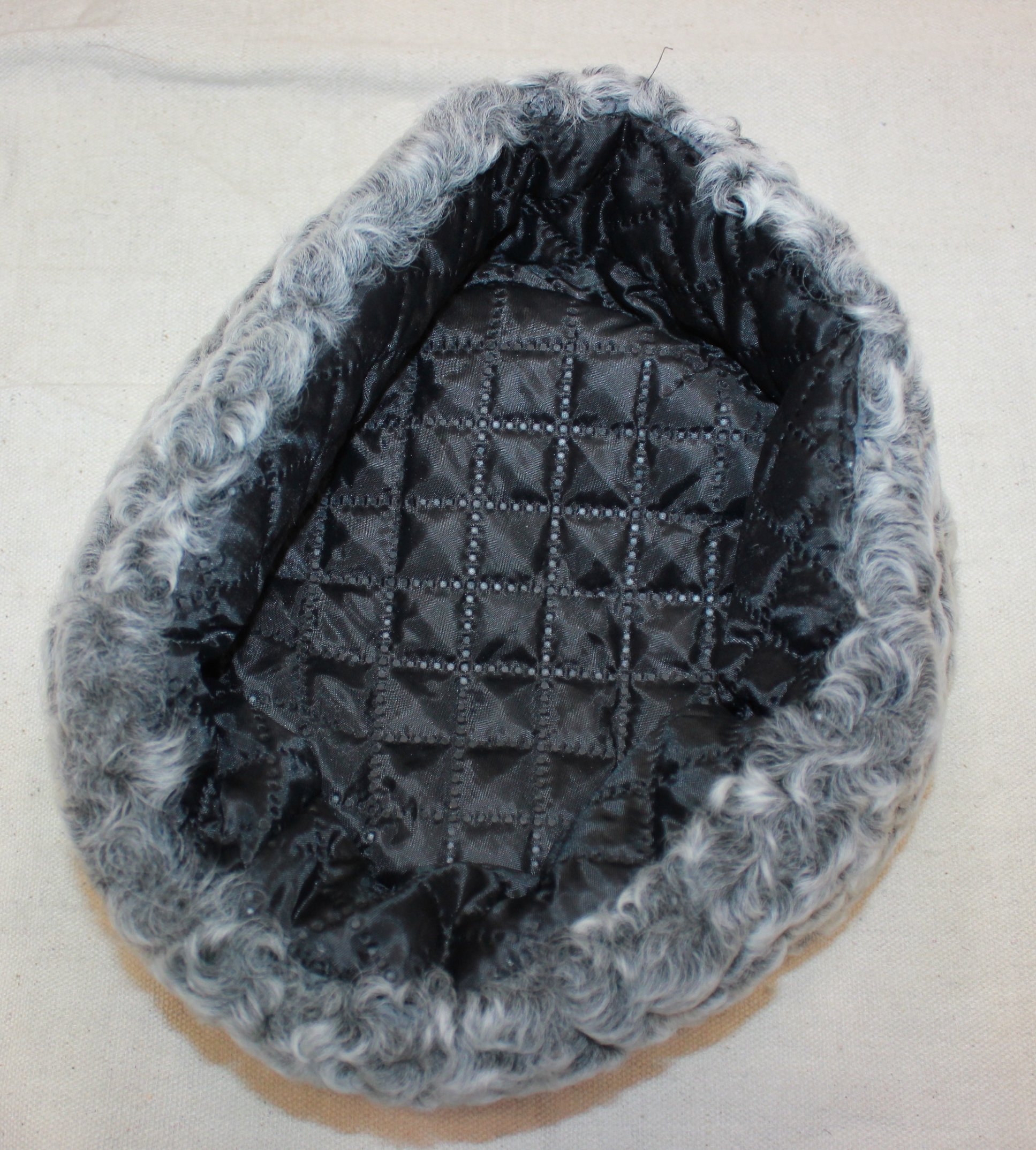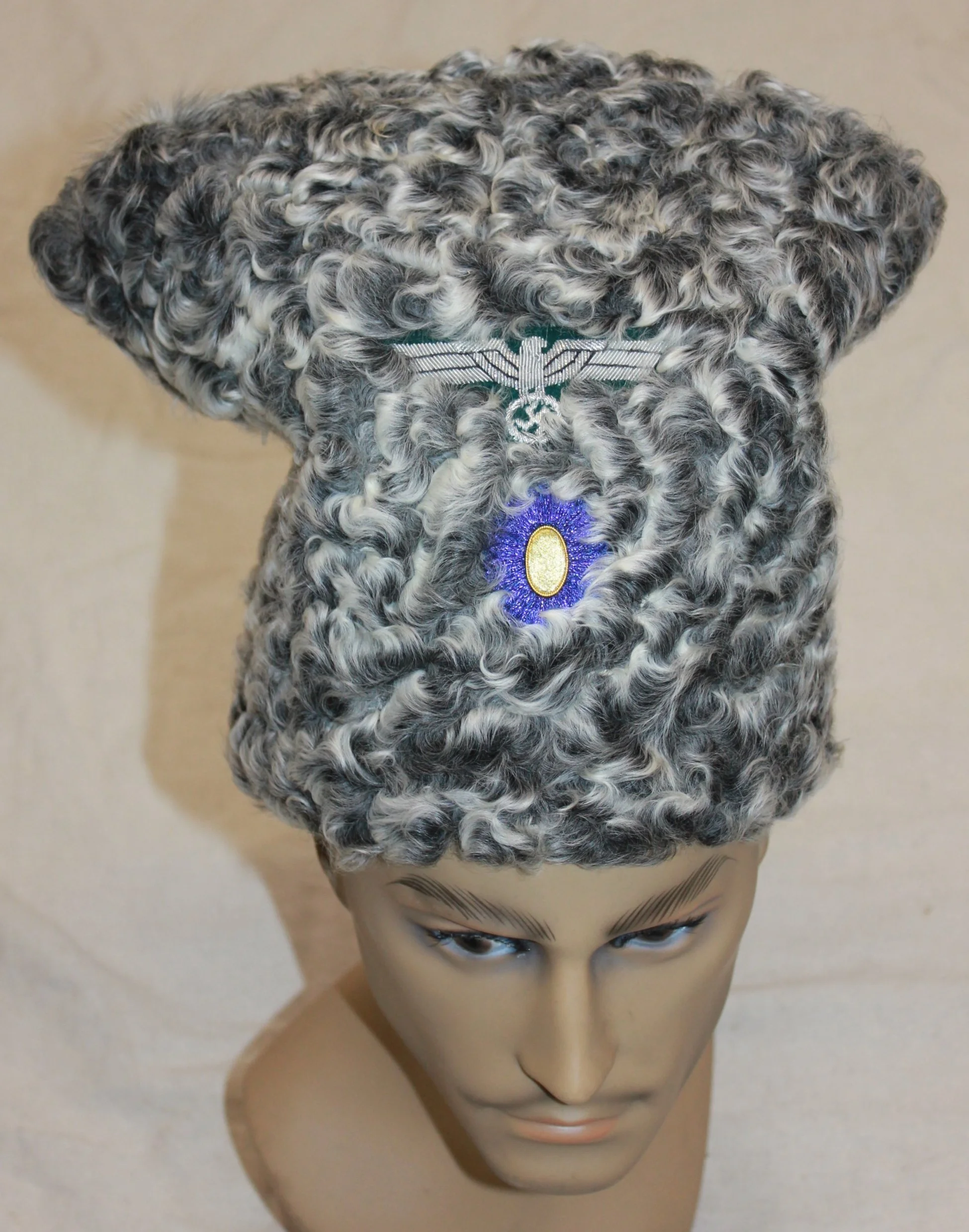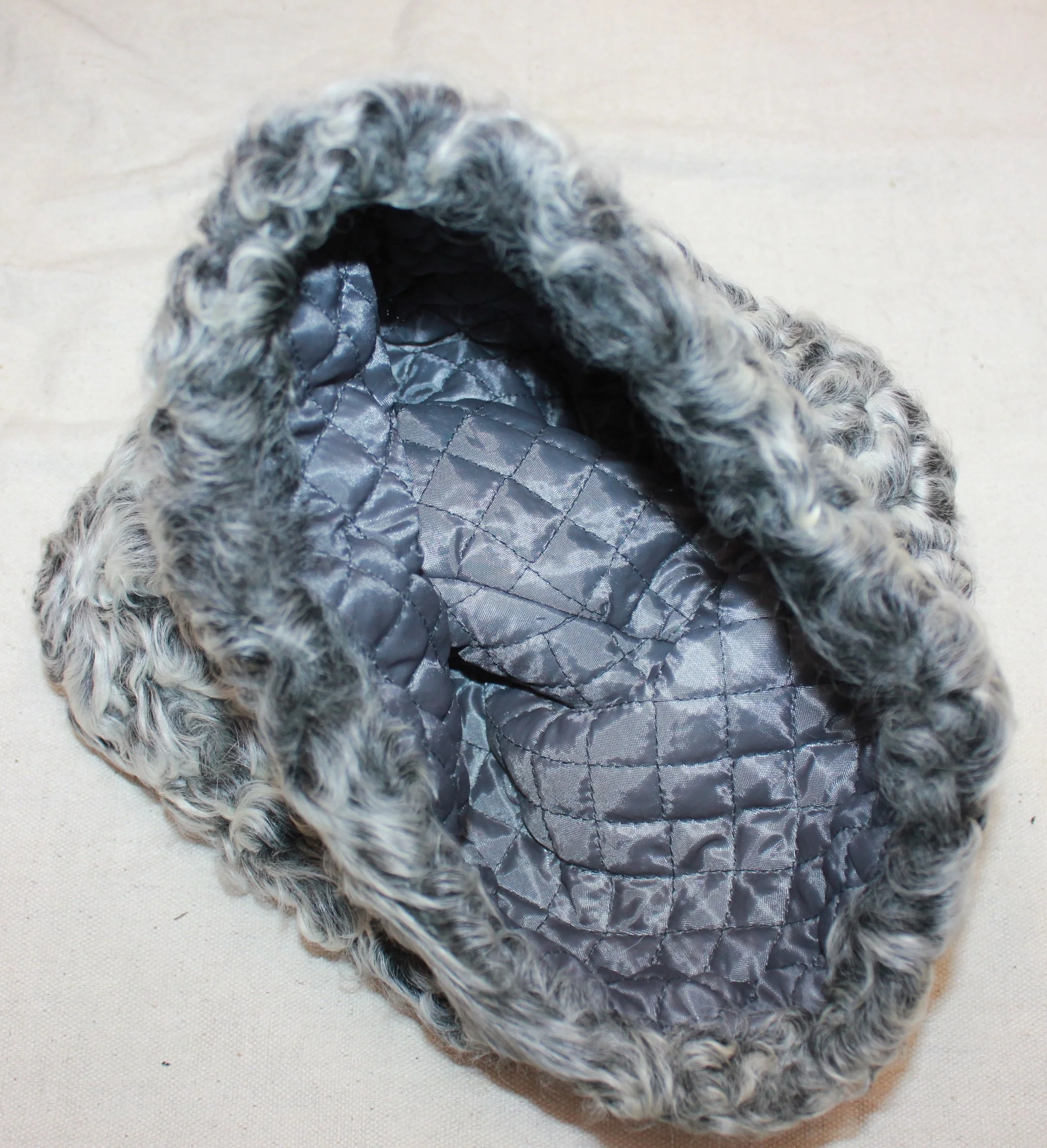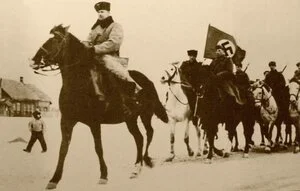Heer, Cossack Volunteers:
* ”Upgraded Pictures” Hauptmann, Don Cossack Volunteer ~ Uniform Set:
In an attempt to show a Cossack’s dress or traditional, more even the Ceremonial uniform, We’ve come up with this, Light and maybe cheaper than one might expect, it is what it is, hope we got it pretty close. Real ones from the time a pretty Unobtainable, and a cut-off from the Russians now, could be tricky too. And as a set, we also have an example of this Hauptmann German Service uniform as well.
It carries the German-Dark Yellow piping appropriately, as he is a skilled horseman, and, basically, an element of the German Cavalry now. It shows his Rank as Heer-Captain, and the traditional 3rd Regiment number applied to it. Both uniforms also have the ‘Heer National Insignia’ applied to them, which was against regulation. The shoulderboards were rare too, but he has the lot, and is not too worried about it either, as both have the “Don-Cossack” shield proudly applied to them as well.
The Uniform has the Ritterkreuz, a very rare item amongst the volunteers. It’s possible he may have been a German officer assigned to work with the Cossacks and received the dress uniform as a gift. The jacket is a lightweight, summer uniform in the M36 officers’ cut, with all the quality of a German uniform. Along with his Knights Cross of the Iron Kross, aka the “Ritterkreuz”, he has earned the ‘German Badges’ for more than 3 major assaults, and the ‘For Wounds’ Badge (up to 5 with the silver class). He would have likely had a set of matching trousers & shoes, or breeches, with officers, and an officer's belt with a sidearm.
This uniform set has 3 hats, two with the black dress uniform, the one that came with it has the red top with silver cross over the top, but I have this completely black hat too-just to show the option.
Don Cossack, 1st Cossack Cavalry Division:
Stuck between the Nazi-Germans and the Communist-Russians, Many of the Don decided to choose the latter, and they formed up in Poland in the late summer of 1943. This unit included the Don, Kuban, Terek, & Siberian Cossacks combined into two brigades, each with three saber squadrons and one Artillery battalion.
The Division fought against partisans in Yugoslavia from the fall of 1943. This Cossack wears a standard German Army tunic with special insignia added. His Don tribal link is shown by the sleeve shield and the medal for service from 1941 as part of the independent Don squadron. His traditional Cossack cap now has German national insignia. He still wears Russian-style Cossack-black/blue breeches with a red stripe; he would have had tall boots and a leather belt, much of his kit coming from the Germans. He also proudly retains his hood/scarf and *Cossack Hat.
*I can’t put my finger on it, but it seems every time I do a photo shoot on a cossack uniform, they seem to gain decorations, sorry, I get carried away I guess, perhaps they had nowhere else to go as they got found in the collection, yes these, as with most of my uniforms are over-decorated, keeping in mind, most have been in the collection 15-20 years, and in 20 years you gather a few decorations, but the Russian volunteer’s especially, not likely to be recognized for their actions.
**Note: I realize some Cossak people may hate these pictures and collect, I don’t mean to make anyone look bad, just some of the history, and I may have merered these uniforms, but they are some of the older in the collection and been through a lot over the years, I am trying to fix that, and make them look like something of the period. In the photoshoots, here again, there are changes in them. This originally had a ‘Red-Top with a silver braided cross on the top of the fur hat called a Papakha, and I shot pictures of it with an all Black one, because I was confused, and I have like 6 extra hats now somehow? I don’t know if one is correct and the other wrong, just telling you why you may see variations in the pictures sometimes. I do try to have them looking “Right” when I do these shoots, with what I have, or could find quickly enough for the quickly put-together shoots. Note: Not shown are a set of gray leather-seated breaches on hbt, I need to take pictures of them and get them on here!
*”UPDATED Pictures” Unteroffizier, “Platoon Leader” 1st Cossack Division, Guard Troop:
This Cossack Unteroffizier is from the Kuban Kosaken Reiter Regiment 6 and has been selected to be a member of the divisional headquarters guards or ‘Konvoy’. The Unteroffizier represents the many Cossacks who viewed serving with the Germans as a way of fighting for their independence (and for their very existence) and to save their home, they thought and wanted to resist the hated Soviet Government.
Cossack units were being put together since late 1941, and this man is part of the 1st Cossack Division, which fought on several fronts before they surrendered to the English Army, who in turn, turned them over to the Red Army for prosecution, and that was not good for the Cossacks, their punishment was terminal in most cases.
But this Cossack is not there yet, nor ready to swim the Rhine River. He is at the height of his career with the Germans, but not maybe aware of that. He has several ‘Ost Truppe’ Decorations. like the 2nd class in gold. and several others, and the German General Assault Badge, EK-II on the ribbons bar, as well as service in Romania, and the ‘Winter / Russia’ award. The M-40 Issue-Tunic original had decorations in a regular form on the front, a Cossack then may have done that, but it was cleaned up with a ribbon bar later.
The uniform also has some other specific insignia applied to it as a good reference, like the collar insignia of crossed lances, boxed in with a silver weave. and the collar carries in German fashion, the silver ‘Senior NCO’ edging around it. Yet not all the Russian is gone either, with the Cossack Guards insignia on his sleeve, and the shoulder boards are still Russian type, red, but all these insignia got confusing with these troops in WWII, as their roles changed a lot. He has 2 strips of the silver weave material, for the Germans, meant he was up for promotion or a candidate for NCO or Officer school, which meant He added in Russian style ‘Reversed Chevrons’ on each sleeve too.
He wears the traditional black fleece Kubanka hat (note the uniform was shot with a gray hat as well), but with a twist, having German officer-cap insignia added to it, a common modification with the volunteers. He was issued an M43 cap as well and wore that at times too.
Against regulation, he wears the German ‘Heer’ National Eagle and could have been on the uniform as he was issued it, possibly applied at the jacket factory. Hi’s trousers are the stretchy black Cossack Breeches, black Cavalry boots, a black belt, possibly with a cross strap, and on his side his Russian Cavalry Saber, and a mix of German and Russian holsters and weapons, cartridge belts, etc.
The Cossacks’ first engagement against the Red Army happened in December 1944 near Pitoma. The fighting resulted in the Soviet withdrawal from the area. In January 1945, the 1st and 2nd Cossack Divisions were transferred to the Waffen-SS. As I. SS-Kosaken-Kavallerie-Division, it became part of the newly formed XV SS Cossack Cavalry Corps.
*It’s been pointed out to me that the uniform collar tabs are incorrect, caught me again; And now, I “Fixed It” the collar tabs in the original photoshoot had officer-style collar tabs, now they EM style “Officially”. In the period photos, they do not have a silver braid-boxed collar tab either, perhaps they’re not platoon leaders? The decorations can be speculated. The Germans were not known for decorating volunteers. Our original shoot shows some interesting medals, but rather they actually fit here id speculative at best, and a more appropriate ribbons bar has been added, even so, I don’t think many of these Wehrmacht-Volunteers rarely received anything of any recognition, it was pretty rare.
You may have also noticed that some of the “hoods”, worn like a cape, seem to have made their way onto the different uniforms. In different photoshoots, because they are always rushed together, driven fifty or hundreds of miles, a couple of times, in the back of a truck, and all shot in a few hours or a day, I admit, I’ve made mistakes and gotten confused, I suppose, a few times. There are two hats for this uniform now, though it’s been pictured and several more, the one that came with it originally, and one I liked with it, both fit it well.
*Wachtmeister, 2. Schwadronen, Terek Kossacken, Reiter-Regiment 4, Wehrmacht-Volunteer:
This Wachtmeister represents one of the many Cossacks who viewed service with the German Wehrmacht as a way of starting the fight for their independence of their home region and as a way of resisting the Soviet Government. With Cossack units being formed in late 1941 this man is part of the 1st Cossack Division, which fought on several fronts surrendering to the British Army in 1945, only to be turned over to the Soviet ‘Red Army’ for prosecution, and the few who survived the war, and the escape from Russia, to a grizzly fate.
This Cossack has shown bravery and leadership, winning the Easter Peoples Awards, and early campaigner; he has the Ost Front Campaign ‘Winter 1941-42’ Ribbon, and the EKII even. Participating in “Operation Rosselsprung” against Tito’s partisans in Yugoslavia, earning him the Anti-Partisan Award in Silver, the other combat operations secured the General Assault Badge. Note again that my Cossack Volunteers, for some reason, keep gaining decorations. I admit this rarely happened that foreign volunteers were recognized for anything, but I had acquired them somehow, and they do need a home, my story, and I’m sticking to it.
The uniform is based on the German pattern M-36, with the unique Cossack insignia applied to it, notably the divisional collar patches, Terek National sleeve shield, and blue piped shoulder boards.
He wears his Hood/ Cape, and Cavalry Sword along with his black fleece ‘Cossack Kubanka’ hat, with the traditional Terek cockade and the blue top, but sometimes they wore the M43 around their German Comrades, to be identified as German Troops, and not shot by both sides!
*No! The brown thing is not a squid! I couldn’t find the gray Officer style hood, but I did find this Brown one, and it had no home, so I’ll put it in here.
*Major, Siberian Kossack, Volunteer, Reiter-Regiment 2:
Siberian Cossacks were Cossacks who settled in the Siberian region of Russia at the end of the 16th century, following Yermak Timofeyevich’s conquest of Siberia. In early Siberia, practically the whole Russian population, especially the serving men, were called Cossacks, but only in a loose sense of being neither landowners nor peasants. Most of these people came from North-West Russia and had little connection with either the Don or Zaporozhian Cossacks.
Siberian Cossacks participated in many military conflicts of the 19th and 20th Centuries. In 1918 Siberian Cossack Host was officially disbanded. Many Siberian Cossacks formed military units and joined Admiral Aleksander Kolchak in his struggle against the Bolsheviks.
Upon the formation of the unit in April 1943, the Division was dispatched to Croatia, where they were placed under the command of the Second Panzer Army and were used for rear area security for the most part.
The Division’s first fighting engagement was on October 12, 1943, when the unit was dispatched against Yugoslav partisans in the Fruška Gora Mountains. In the operation, the Cossacks aided 15 tanks and 1 armored car and captured the village of Beocin with the Partisan HQ. Subsequently, the unit was to protect the Zagreb-Belgrade railroad and the Sava Valley. Several regiments of the division took part in various anti-partisan operations and guarded the Sarajevo railroad against the partisans. As part of the wide anti-partisan operation Napfkuchen, the Cossack division was transferred to Croatia, where it fought against Croatian partisans and the Chetniks in 1944. In 1944, they were fighting in Yugoslavia, where they suffered heavy losses when the Siberian Cossacks were surrounded by the Partisans and held for several days till other Cossack regiments were able to provide relief and break the encirclement.
A note on the Cossack’s “Sleeve Shield”, there was an earlier style, more of a squared shield, with the upper and lower parts of the X while and the side triangles red, above that “ACB” embroidered in white. In “Cyrillic,” I understand it means A=Astrakhan (Town), C=Svodnoe (United), and B=Voisko (Army) or something like this. The town of Astrakhan is near the Caucasus, the Caspian Sea about 200 km north of Chechnya.
The Astrakhan or Siberian Cossack Group numbered about 120,0 it is said, and they did forward reconnaissance work and were rated quite highly by the Germans. There have been pictures of Cossacks wearing both of these shield patches, the latter (seen on my uniform here) with the yellow and the blue was issued to the volunteers of the 2nd Siberian Cossack Cavalry Regiment. The inscription (Which resembles NCB in English) represents the “ACB” Cyrillic letters. The Siberian Cossack units were formed in late 1943, with the introduction of the insignia in early 1944.
The Siberian Cossack Major wears an M40 cut wool tunic with a mix of German and the authorized Cossack insignia. I’m not sure exactly why, an interesting phenomenon. My Cossacks tend to be very decorated people, and as of late, this fellow is one decorated combat veteran. I don’t think they received a lot of recognition from the higher command. Through the years I maybe got carried away adding decorations when I didn’t know what to do with a medal and the like, he represented the regiment and wore several '“Orders of the Eastern Peoples awards” as well as the rarely seen German Iron Cross II Class as well as the War Merit Badges I and II both with Swords.
The Imperial Badge is unclear but could contain some family or unit history. The uniform retains the ‘Cossack Cape’, actually it’s a hood and worn as a scarf handy in the cold, gray with a cross on it, it’s said to be an officer's hood, but I’ve seen all kinds, brown and gray, many adorned with black or other color crosses on them. He wears blue breeks with a yellow regimental stripe on them. He would have had Tall boots and likely Soviet equipment, mixed with them, strictly what was available at the time.
These men often used their Soviet-made equipment, weapons, and uniforms, and this may have led to incidents of mistaken identity while fighting directly alongside the German Forces.
Note: Just to confuse us a bit more, the uniform has several hats now for it, it’s a long story why, and I’m no expert on them, so I stuck on similar insignia and show them here too, I shot it with a hat having a golden cross over the top, and now they say thats a generals hat, but if you buy one 90% are like that, so I question it, I thought officer was a silver cross across the top, but have seen crosses and line and strins all over across the top- so I cant confirm any or if I am incorrect. The Astrakhan Fur Cossack Hat, in the Black and gray colors, shows a different style cut like the large “Imperial” style, and the low-wide look to it, and some of the Cossacks never bothered changing the Russian style cockade to the German tri-color type, when they did have German insignia on them they were often the Officer style National eagle and wreath, for all ranks as I see it. There were probably regulations for this, but if a guy just wants the insignia on his hat, and was willing to fight…I imagine it was okay with the Germans in the field.
Cossack Winter Jacket:
The jacket here is just an example of a lot of what was worn by both Russians and Germans in the bitter winters they fought in WWII, and as such I have used it in various photo shoots, its quite a small, simple wool rough jacket, and as so worked great, as they could be worn with thick gloves and overs etc.


















































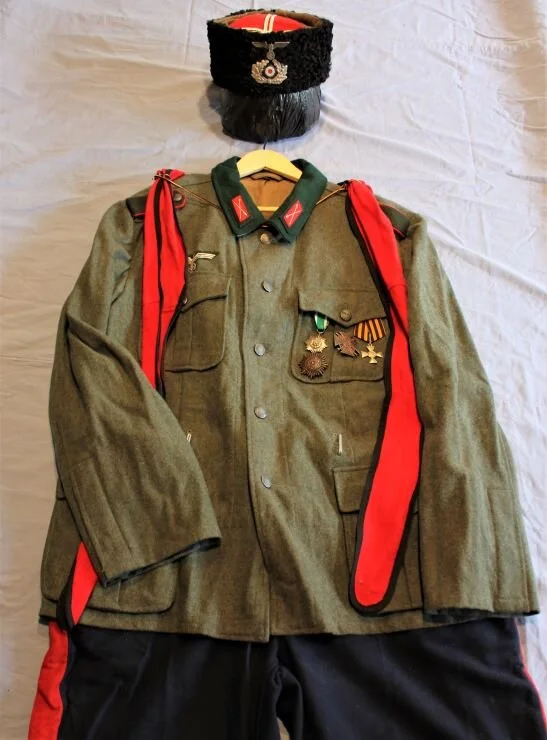























































![bb2d8_1765[1].jpg](https://images.squarespace-cdn.com/content/v1/61355b53c1baef12641a2de9/1648514765929-WVPWWRA378B8BCXUM7IT/bb2d8_1765%5B1%5D.jpg)

